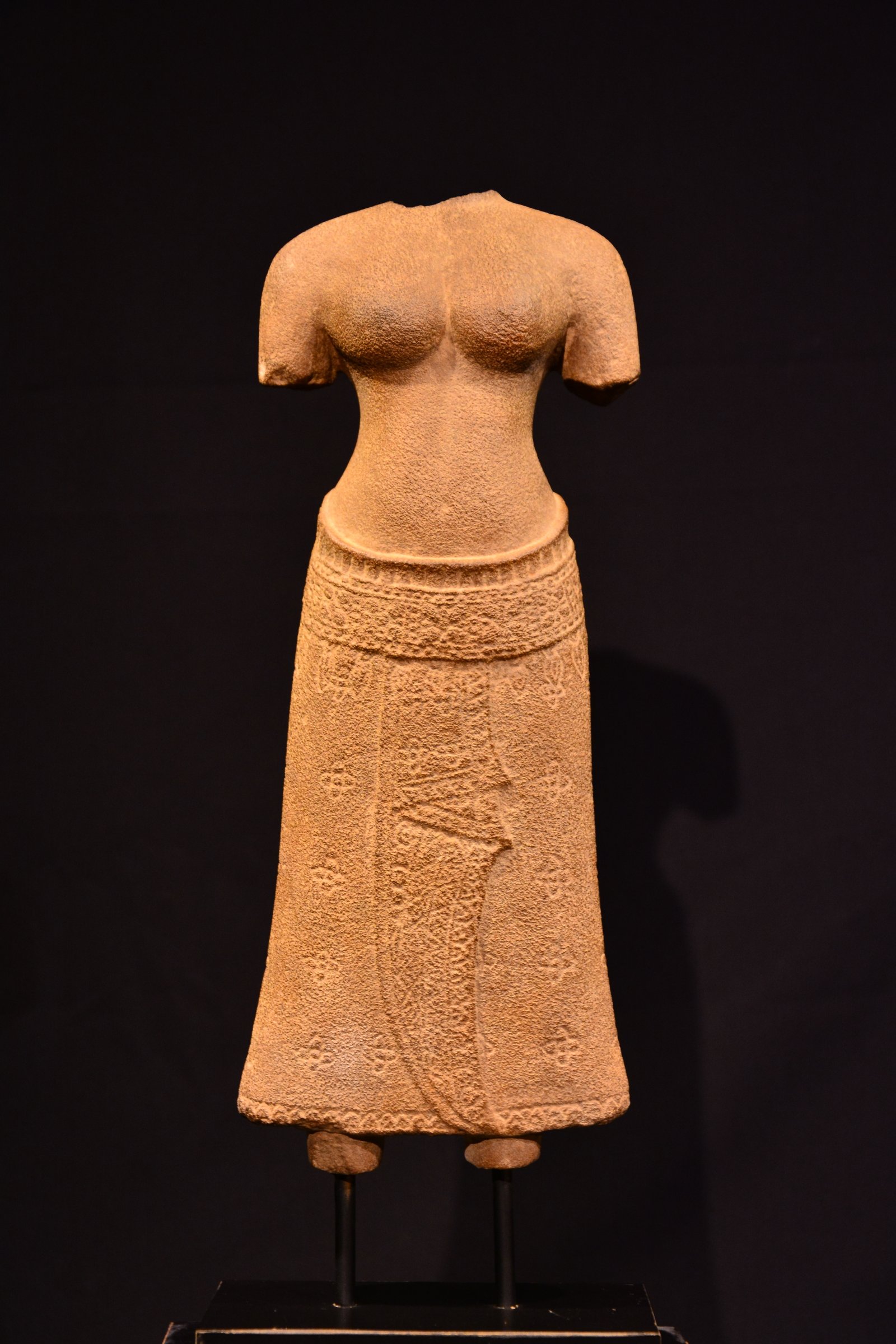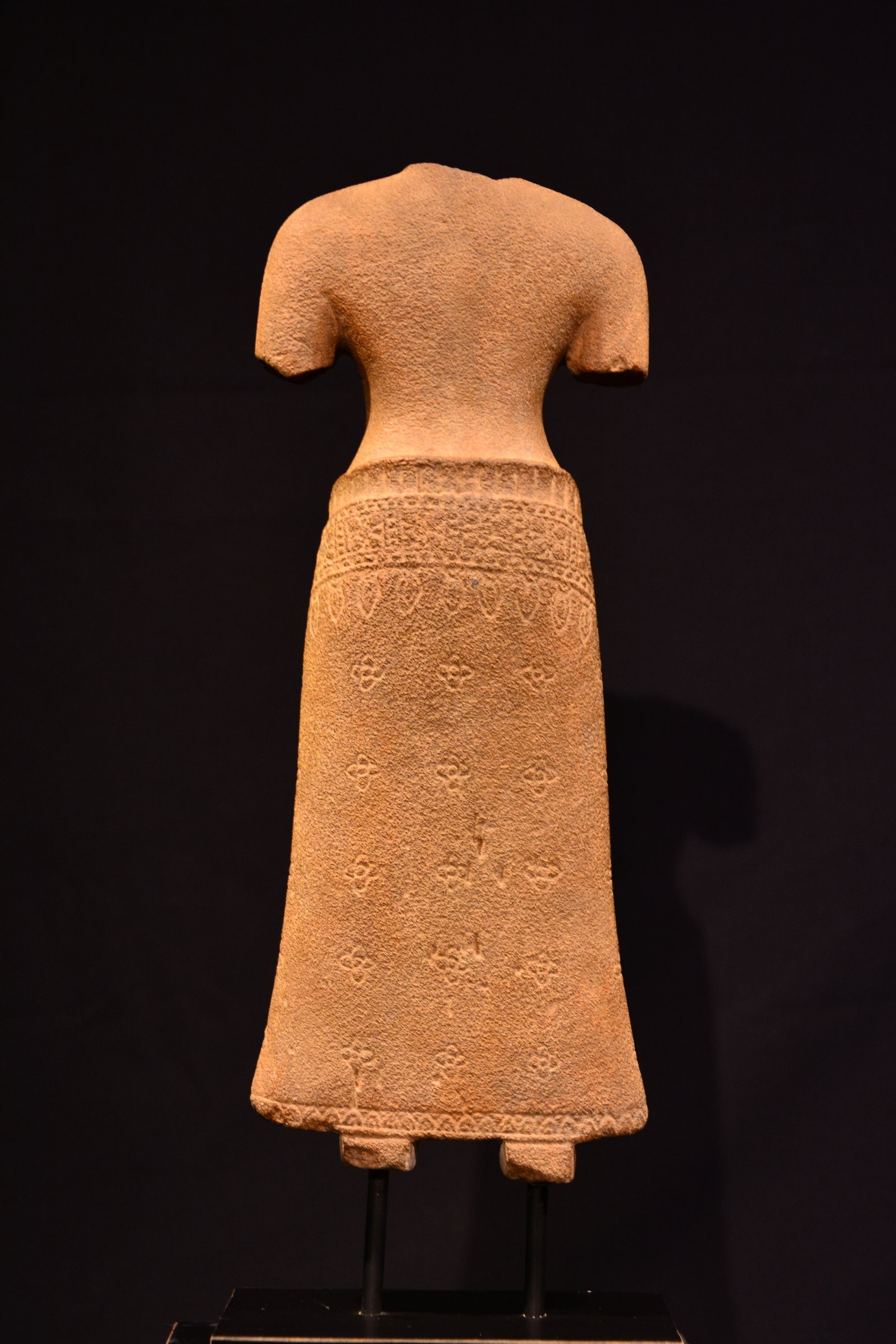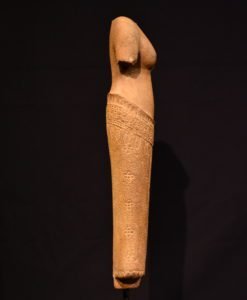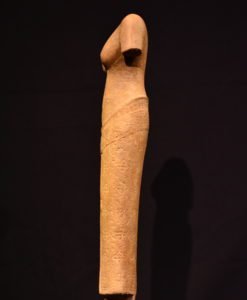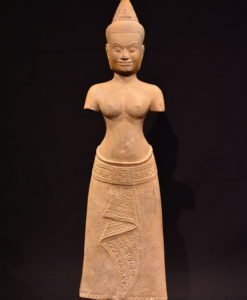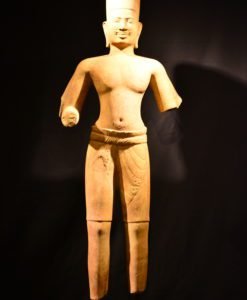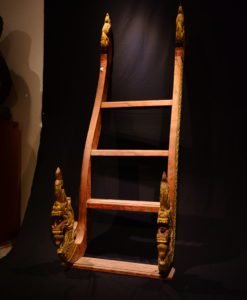Exquisite Sandstone Torso of Prajnaparamita – A Masterpiece of Bayon Period Khmer Art
ITEM DESCRIPTION
A Rare Testament to Khmer Spirituality and Artistic Excellence
This exquisite sandstone torso of Prajnaparamita, originating from the Bayon period (late 12th – early 13th century CE), stands as a testament to the grandeur of Khmer artistry and spiritual devotion. Representing the embodiment of wisdom and transcendental knowledge in Mahayana Buddhism, this statue exhibits the delicate refinement and regal elegance characteristic of Angkorian sculpture during the reign of King Jayavarman VII.
Carved from fine-grained sandstone, the sculpture maintains a striking presence, its untouched and original condition revealing a subtle pale patina that has developed over centuries. Despite minor excavation marks, it remains remarkably well-preserved—an exceptionally rare find for collectors and connoisseurs of Southeast Asian antiquities.
Artistic and Symbolic Interpretation
Prajnaparamita, revered as the Goddess of Transcendent Wisdom, is one of the most important divine figures in Khmer Mahayana Buddhist iconography. Her depiction follows traditional Khmer sculptural conventions:
- Noble Poise and Elegance: The torso exudes an aura of serenity and grace, characteristic of Khmer divine representations. The well-defined curves of the bare upper body symbolize purity and transcendence.
- Intricate Sampot with Stylized Floral Motifs: The lower half is adorned with an elaborately carved sampot, featuring stylized floral designs and a masterfully rendered fishtail pleat, hallmarks of the Bayon period’s evolving aesthetic style. The detailing is finely etched, revealing the high level of craftsmanship employed in its creation.
- Regal Waist Adornments: The jewel-like embellishments around the waistline further indicate that this figure was sculpted to reflect divine status, aligning with depictions of deities and celestial beings in Khmer temple reliefs.
- Absence of Hands and Specific Mudra: While the arms are missing, similar examples suggest the figure may have once displayed a gesture (mudra) of teaching, compassion, or reassurance, reinforcing Prajnaparamita’s role as a guide to enlightenment.
The Bayon Period – A New Artistic Vision
This sculpture is stylistically aligned with the Bayon period, a transformative era in Khmer history when King Jayavarman VII (r. 1181–1218 CE) established Mahayana Buddhism as the state religion. Under his patronage, Angkorian art shifted from the earlier Hindu aesthetics of the Angkor Wat period to a more humanized and expressive Buddhist visual language.
The elaborate floral sampot design seen in this torso aligns with Bayon period artistic advancements, moving towards more intricate textile representations than those found in earlier Khmer sculptures. The gentle, naturalistic curves and fluid drapery are indicative of this stylistic shift, reflecting the emphasis on compassion and wisdom in Khmer Buddhist art.
Comparable examples of Prajnaparamita statues from the Bayon period can be found in leading museum collections, including the Musée Guimet (Paris) and the National Museum of Cambodia (Phnom Penh), underscoring the rarity and historical importance of this piece.
Historical Provenance and Rarity
Khmer sandstone sculptures of this caliber, particularly untouched, original pieces with no modern restorations, are exceedingly rare in private collections. This torso is said to have originated from a major or local governor along the Thai-Cambodian border, a region historically known for its proximity to important Khmer temple sites.
While many such sculptures were removed from temple ruins, this piece retains its authenticity, evident in the natural surface aging and excavation traces. Collectors and institutions value such pieces not only for their artistic merit but also for their historical integrity.
A Collector’s Masterpiece – Presented with Museum-Quality Display
Measuring approximately 34 cm in height, this torso possesses an imposing yet refined presence, making it ideal for a sophisticated private collection or a museum display. It is presented on a custom stand, ensuring stability while enhancing its visual impact.
For discerning collectors, this statue represents more than just an artwork—it is a fragment of a lost empire, a tangible link to the spiritual and artistic mastery of the Khmer civilization.
References
- Baptiste, P. & Zéphir, T. (2008). Khmer Art: The Sculptural Heritage of Angkor. Paris: Musée Guimet.
- Rooney, D. (2012). Angkor: Cambodia’s Wondrous Khmer Temples. Bangkok: River Books.
- Jessup, H. (2004). Art and Architecture of Cambodia. New Haven: Yale University Press.
- National Museum of Cambodia. (2023). Bayon Period Sculpture Collection. Phnom Penh
Origin: Cambodia
Period: Bayon
PRODUCT DETAIL
Medium: Sandstone
Dimensions:
Height 34 cm
Length 8 cm
Wide 12 cm
Condition Report: –
Please keep in touch for Price and more information: Mallika1013@gmail.com



